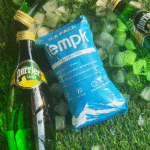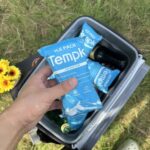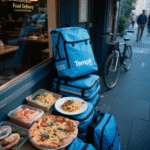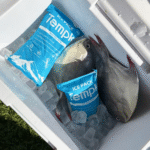Biodegradable Dry Ice Packs for Camping: How They Revolutionize Outdoor Cooling?
Keeping food fresh on a camping trip no longer means relying on messy ice or single use plastics. Biodegradable dry ice packs for camping combine ultra cold performance with sustainable materials, giving you days of frost without the environmental guilt. These packs use either solid CO₂ produced from recycled emissions or plant based gels sealed in compostable films, so they provide long lasting cooling while breaking down harmlessly at the end of their life. In this guide you’ll learn what makes these packs unique, how to choose and use them, and the latest trends shaping eco friendly cold chain solutions.

How biodegradable dry ice packs differ from traditional ice and why solid CO₂ or plant based gels offer superior cooling.
Why eco friendly materials and compostable films matter, including how packs degrade into water, carbon dioxide and biomass.
How to select the right pack for your trip, with sizing tips and handling guidelines.
Latest trends and innovations in 2025, from reusable packs to smart sensors and hybrid cooling systems.
Practical advice for safe handling and disposal, so your adventure stays both cool and green.
What Makes Biodegradable Dry Ice Packs Unique?
Biodegradable dry ice packs combine ultra cold performance with earth friendly materials. Traditional dry ice packs contain solid carbon dioxide that sublimates at −78.5 °C, delivering two to three days of intense cooling without any meltwater. In biodegradable versions the pouch is made from compostable or recyclable materials, such as polyethylene film that degrades into water, carbon dioxide and biomass. Other designs use plant based gel refrigerants sealed in recycled plastic pouches, offering similar cold retention but with the added benefit of compostability and reusability.
Understanding the Materials
Biodegradable dry ice packs fall into two main categories:
Solid CO₂ packs – These pouches contain pellets or slices of recycled carbon dioxide that sublimate directly from a solid to a gas. Because the CO₂ is recovered from industrial processes such as ethanol fermentation or ammonia synthesis, the packs repurpose carbon that would otherwise be vented to the atmosphere. Their compostable outer films break down after use, leaving no heavy metals or harmful residues.
Plant based gel packs – Instead of solid CO₂, these packs use a plant derived hydrogel that freezes at around 0 °C/32 °F. Brands like TerraTemp and Nutri Ice offer compostable or recyclable pouches filled with water based gels that can even promote plant growth. When you’re done, you can pour the gel on your garden and recycle or compost the pouch.
Both types provide leak proof durability and long lasting cooling. Plant based cold packs keep their shape even when thawed and are reusable, biodegradable and compostable. Solid CO₂ packs deliver much colder temperatures, ideal for freezing meats and ice cream; they sublimate completely without leaving water behind.
Comparative Properties
| Type of Pack | Construção | Environmental Benefit | O que isso significa para você |
| Biodegradable CO₂ Pack | Solid carbon dioxide pellets sealed in a compostable film | CO₂ originates from recycled industrial sources; pouch degrades into water, carbon dioxide and biomass | Fornece temperaturas ultra frias (–78,5 ° C.) for 2–3 days with no meltwater; once used, allow the pack to sublimate outdoors and compost the pouch |
| Plant based Gel Pack | Plant derived hydrogel in a recyclable or compostable pouch | Gel can be poured onto plants as fertilizer; pouch is recyclable or compostable | Ideal for keeping goods around 0–5 °C; reutilizável, leak proof and maintains shape when thawed |
| Reusable Dry Ice Hybrid | Combination of dry ice and Phase Change Material (PCM) pacotes | Reduces the amount of dry ice required and lowers carbon footprint | Provides controlled temperatures for mixed loads (congelado e refrigerado); refillable packs cut waste by up to 20 % |
Dicas e conselhos práticos
Weekend backpacking: For a two day trip, one biodegradable CO₂ pack per 5–10 lb of frozen goods keeps meat and ice cream rock solid. Put the pack on top of your food so the cold air sinks around it.
Family camping: Combine a plant based gel pack with a CO₂ pack. Use the gel pack for produce and beverages and the CO₂ pack for frozen items. This hybrid approach extends cooling and reduces the amount of dry ice needed.
Shipping gifts home: If you’re mailing fish or venison from your trip, use a compostable dry ice pack and label the parcel “UN 1845” for safety compliance. Fill voids with paper to limit air pockets and always provide disposal instructions to the recipient.
Caso real: Many meal kit companies switched to plant food gel packs like Enviro Ice so customers can pour the nitrogen based gel on houseplants and recycle the pouch. This move reduces landfill waste and turns packaging into a useful product, highlighting how sustainable refrigerants enhance user experience.
How Do Biodegradable Dry Ice Packs Enhance Your Camping Experience?
They combine extended cooling with a smaller environmental footprint. Traditional ice melts quickly and leaves your cooler soggy, while gel packs may not be cold enough for frozen meats. Biodegradable dry ice packs keep foods frozen for two to three days and then dissolve harmlessly or become fertilizer. Porque o gelo seco sublima diretamente ao gás, there is no water runoff to spoil bread or produce, and packs take up less space in your cooler.
Beyond Ordinary Ice
In side by side comparisons, dry ice packs outperform regular ice and standard gel packs. Dry ice maintains temperatures around –78.5 °C and remains effective for 2–3 days, whereas regular ice sits at 0 °C and melts within 12–24 hours. Gel packs keep items chilled between 0 °C e 5 °C for 12–36 hours, making them better suited for drinks or produce. Phase Change Material packs can be tuned between 0 °C and –20 °C and last 2–4 days. Choosing biodegradable versions of these products eliminates single use plastics while still delivering comparable performance.
Comparative Performance of Cooling Methods
| Método de resfriamento | Faixa de temperatura | Duração | Bagunça | Melhores casos de uso | O que isso significa para você |
| Biodegradable CO₂ Pack | −78,5°C (Sublelimates) | 2–3 dias | Nenhum (turns to gas) | Long camping trips, carnes congeladas, sorvete | Keeps food frozen without water runoff; ideal when you need days of sub zero cold |
| Gelo regular | 0 °C | 12–24 horas | Alto (melts to water) | Viagens curtas, chilled drinks | Cheap and available, but creates puddles and doesn’t keep food frozen |
| Plant based Gel Pack | 0–5 ° C. | 12–36 horas | Médio (some condensation) | Produção fresca, laticínio, bebidas | Reusable and non toxic; keeps items cool but not frozen |
| Pacote pcm | Tunable 0–−20 °C | 2–4 dias | Mínimo | Cargas mistas (congelado e refrigerado) | Offers controlled temperatures; combine with dry ice to extend duration |
Tips and Advice for Your Camping Cooler
Plan your layers: Place frozen items at the bottom, dry ice or biodegradable CO₂ packs on top, and use gel packs around sides. Air frio afunda, so this configuration maximizes efficiency.
Pré-resfrie tudo: Freeze meats and pre cool beverages at home. Pre chilling your cooler with ice the night before can add several hours of cold retention.
Limite de aberturas: Cada vez que você abre o refrigerador, warm air rushes in. Group meals and snacks so you open the cooler less frequently.
Use isolamento adequado: Invest in a high quality cooler with thick walls. Vacuum insulated panels or foam liners further prolong cooling.
Caso real: Durante um 2024 outdoor festival, a food vendor used hybrid packs—one biodegradable CO₂ pack and two plant based gel packs—to keep 20 lb of frozen seafood and chilled salads fresh for 48 horas. The gel packs were later poured into planters, and the dry ice pouch composted, turning waste into nutrients.
How to Choose the Right Biodegradable Dry Ice Pack?
Match your pack to your needs by considering size, duration and material. Biodegradable dry ice packs come in various weights and dimensions—from 6 oz pouches for lunch bags to 24 oz packs for large coolers. For solid CO₂ packs, calculate one 5–10 lb pack per 5–10 lb of frozen goods for a 24 hour outing and increase to a 1:1 ratio for multi day trips. Plant based gel packs are sized by ounces and are ideal for produce and drinks.
Evaluating Features
When shopping, look for the following features:
Biodegradable pouch – Choose packs with compostable or degradable films such as polyethylene that breaks down into water, carbon dioxide and biomass.
Leak proof construction – Structured plant based cold packs are designed to retain their shape and will not leak if punctured.
Reutilização – Many packs are designed for hundreds of uses and have an 18 month shelf life when stored below 86 °F away from UV light.
Food grade materials – Ensure the gel or pouch is made from FDA approved recycled plastic. Brands like Terra Ice and Nutri Ice provide gels that can be poured onto plants.
Safe Handling and Disposal
Biodegradable dry ice packs require some safety precautions:
Use luvas – Solid CO₂ can cause frostbite; handle packs with insulated gloves. Keep packs away from bare skin and never place them directly on food without a barrier.
Ventilar – In enclosed spaces (cars or tents) O gás CO₂ pode acumular-se. Use packs in well ventilated coolers or with vented lids.
Deixe sublimar – Allow dry ice to evaporate outdoors. Never dispose of solid CO₂ in sinks or trash where expansion could cause damage.
Recycle or compost – After the pack has sublimated, compost the pouch or recycle it according to local guidelines. For plant based gel packs, pour the gel on plants and recycle the pouch.
Armazene adequadamente – Keep unused packs in a cool, dry place away from sunlight to maintain shelf life. Plant based gel packs should be frozen 48–72 hours before use.
Decision Matrix
| Cenário | Pacote recomendado | Justificativa |
| Overnight hike with frozen steaks | Biodegradable CO₂ packs sized 0.5 libra por 5 quilo de comida | Provides sub zero cooling without flooding your backpack; pouch composts after use |
| Family picnic with salads and drinks | Plant based gel packs (6–12 oz each) | Keep food around 0 °C; gel can be poured on plants and pouch recycled |
| Shipping home-caught fish | Combination of CO₂ and PCM packs | Hybrid system extends cooling duration and reduces CO₂ consumption |
| Emergency freezer backup | Multiple CO₂ packs (10 lb per day for a fridge) | Keeps refrigerator or chest freezer cold for 24–48 hours during power outages |
Caso real: During a hurricane, one household placed 40 lb of biodegradable CO₂ packs on top of frozen food in a chest freezer, maintaining safe temperatures for three days until power returned. The empty pouches were composted, and the plant based gel from hybrid packs nourished the garden.
Innovations and Trends in 2025: Soluções de resfriamento sustentáveis
The cold chain industry is embracing sustainability and data driven technologies. Em 2025, several innovations will transform how outdoor enthusiasts and businesses cool their goods.
Overview of Trends
Recycled CO₂ and bio based sources – Dry ice is now produced from recycled CO₂ captured during ammonia or ethanol production. Companies are investing in bio based CO₂ sources to reduce reliance on fossil fuels.
Reusable packs and hybrid systems – New reusable dry ice packs can be refilled hundreds of times, cutting waste by up to 20 %. Hybrid solutions combine dry ice with PCMs or gel packs to lower carbon footprints while maintaining performance.
Sensores inteligentes e monitoramento IoT – Internet of Things (IoT) sensors embedded in coolers provide real time temperature, humidity and vibration data. Predictive analytics alert users to potential spoilage and optimize pack placement.
Rastreabilidade de blockchain – Decentralized ledgers record every handoff in the cold chain, improving visibility and reducing disputes.
Advanced packaging materials – Vacuum insulated panels, aerogels and eutectic plates deliver superior thermal performance while minimizing bulk. These materials allow smaller, lighter coolers without sacrificing cooling duration.
AI and route optimization – Artificial intelligence uses real time traffic and weather data to plan optimal delivery routes, reducing transit time and fuel consumption.
Armazenamento refrigerado movido a energia solar – Off grid solar systems provide reliable power for freezers and coolers in remote campsites. Commercial solar rates between 3.2 e 15.5 cents per kWh make this an economical alternative.
Último progresso em um olhar
Reusable Biodegradable Packs – Packs that can be refilled hundreds of times hit the market, cutting waste significantly.
Refrigeradores inteligentes – Portable coolers with integrated Bluetooth sensors allow campers to monitor internal temperatures via smartphone.
Pacotes Híbridos – Combining plant based gels with CO₂ and PCM packs extends cooling for multi day hikes while reducing the amount of dry ice needed.
Insights de mercado
O mercado global de gelo seco, avaliado em USD 1.54 bilhão em 2024, is projected to grow to USD 2.73 billion by 2032—an annual growth rate of about 7.4 %. Demand from food delivery, vaccine distribution and industrial applications continues to rise. Ao mesmo tempo, sustainability pressures encourage companies to adopt bio based CO₂ sources and reusable packs. Shortages and price volatility from limited CO₂ supply (growing only 0.5 % anualmente) drive innovation in alternative refrigerants and more efficient pack designs.
Perguntas comuns (Perguntas frequentes)
Are biodegradable dry ice packs safe to handle?
Sim, but wear insulated gloves to avoid frostbite when handling solid CO₂. Plant based gel packs are non toxic and food safe. Always use packs in ventilated spaces and allow dry ice to sublimate outdoors.
How long do biodegradable dry ice packs last in a cooler?
CO₂ packs can keep items frozen for 2–3 days, while plant based gel packs maintain chilled temperatures for 12–36 hours. Duration depends on cooler insulation and the amount of ice relative to the payload.
What’s the difference between plant based gel packs and dry ice packs?
Dry ice packs use solid CO₂ and provide ultra cold temperatures for freezing. Plant based gel packs use a biodegradable hydrogel and offer moderate cooling around 0–5 °C. Both types can be composted or recycled.
Can I reuse biodegradable dry ice packs?
Sim. Many plant based gel packs are designed for hundreds of uses and have an 18 month shelf life when stored properly. Reusable dry ice shells are also emerging that can be refilled multiple times.
How should I dispose of biodegradable dry ice packs after my trip?
Allow CO₂ packs to sublimate outdoors, then compost or recycle the film. Para pacotes de gel, cut the pouch, pour the gel on plants or down the drain if marked drain safe, and recycle or compost the pouch.
Resumo & Recomendações
Biodegradable dry ice packs for camping deliver the best of both worlds—powerful, long lasting cooling and eco friendly design. They keep food frozen for days without leaving meltwater, and their pouches break down into benign substances. Plant based gel versions offer moderate cooling and can feed your garden. To choose the right pack, match the size to your payload, look for compostable films and leak proof construction, and consider hybrid solutions for mixed loads. As the cold chain industry adopts reusable designs and smart technologies, switching to biodegradable packs helps you stay ahead of the curve while protecting the planet.
ACTO ACEDIVO PRÓXIMO PASSOS
Assess your trip length and payload – Determine how long you need to keep items frozen or chilled and weigh your food to estimate the number and type of packs required.
Select the appropriate pack – Choose biodegradable CO₂ packs for frozen meats and plant based gel packs for fruits, drinks or short trips. Consider reusable hybrids for long expeditions.
Prepare e embale corretamente – Freeze your goods, pre cool your cooler and arrange layers with dry ice on top. Wear gloves and ensure ventilation during handling.
Descarte com responsabilidade – Allow dry ice to sublimate outdoors and compost or recycle the pouch. Use gel on your plants or pour it down the drain if the product is drain safe.
Mantenha-se informado – Keep an eye on 2025 tendências como sensores inteligentes, blockchain and hybrid refrigerants. These innovations will make your cooling experience safer and more sustainable.
Sobre Tempk
Tempk is a trusted provider of cold chain solutions, offering high performance dry ice packs, Material de mudança de fase (PCM) refrigerants and insulated containers. Com foco na sustentabilidade e inovação, we design products that are reusable, eco friendly and tailored for camping and outdoor use. Our mission is to help you keep food fresh while minimizing environmental impact. Whether you need biodegradable dry ice packs, gel packs or custom insulated bags, our CNAS certified R&D team ensures you get reliable performance and industry leading quality.
Chamado à ação: Ready to elevate your camping cooler? Contact us to explore biodegradable dry ice packs and customized cold chain solutions tailored to your adventure.























